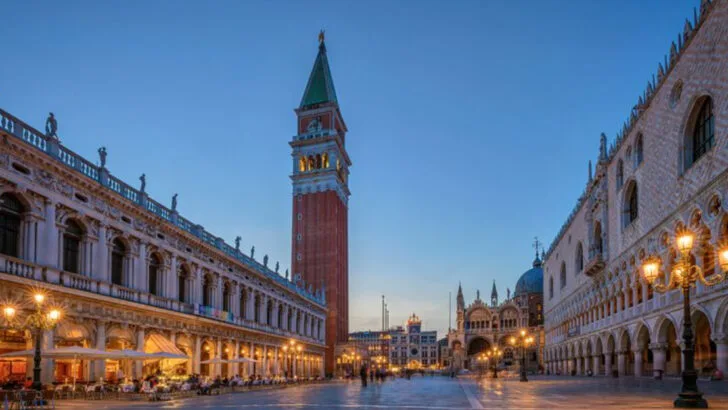Italy doesn’t just whisper history—it shouts it from every stone piazza and hilltop tower. Step into a square and you’re suddenly in the middle of centuries of politics, art, and life that shaped the world. These piazzas are more than open spaces. They’re theaters where emperors marched, artists dreamed, and locals still gather to sip espresso under the sun. Then there are the hilltop towns. Perched high above the countryside, they look as though time hit pause—medieval walls, winding alleys, and sunsets that paint the rooftops gold.
Five piazzas that defined Italy and seven towns that feel untouched by modernity—together they capture the soul of a country that refuses to let its history fade.
Piazza San Marco, Venice
Piazza San Marco is Venice’s crown jewel. It is a bustling hub filled with history and beauty. Known as the “Drawing Room of Europe,” it captivates visitors with its grand St. Mark’s Basilica. The piazza’s expansive open space invites leisurely strolls. Here, tourists and locals alike mingle with friendly pigeons.
The surrounding historical buildings add to its charm. The Campanile offers stunning views over the city. As the sun sets, the piazza transforms into a romantic setting. Musicians fill the air with melodies, enhancing the enchanting atmosphere.
Piazza del Campo, Siena
Piazza del Campo is Siena’s heart, famously hosting the Palio horse race. Its unique shell shape makes it one of Italy’s most beautiful squares. The brick pavement fans out from the Palazzo Pubblico. Visitors are drawn to the Torre del Mangia for skyline views.
The harmonious blend of Gothic architecture surrounds the piazza. Local cafes buzz with life, offering a taste of Tuscan hospitality. Each corner holds stories of Siena’s past. As night falls, the piazza glows under soft lights, a true testament to Italian elegance.
Piazza Navona, Rome
Piazza Navona, with its lively atmosphere, is a tribute to Rome’s artistic soul. Famous for its stunning fountains by Bernini, it attracts art lovers worldwide. The Fountain of the Four Rivers is a masterpiece. Street artists and performers add color to daily life here.
Surrounded by Baroque architecture, the piazza whispers tales of Rome’s rich history. Cafes lining the square offer perfect spots for people-watching. As you sip your espresso, the vibrant energy of Rome becomes palpable. It’s a timeless place where the past and present coexist.
Piazza della Signoria, Florence
Piazza della Signoria is Florence’s political and historical epicenter. Dominated by the Palazzo Vecchio, it serves as a reminder of Florence’s storied past. The Loggia dei Lanzi houses sculptures that captivate art enthusiasts.
The replica of Michelangelo’s David stands proudly, attracting tourists and photographers. This piazza is a living museum where history unfolds at every corner. Elegant cafes offer a front-row seat to Florence’s vibrant life. Whether basking in the Tuscan sun or exploring its art, this piazza is a must-visit.
Piazza Maggiore, Bologna
Piazza Maggiore, Bologna’s central square, is a testament to community spirit. It is flanked by impressive medieval and Renaissance buildings. The Basilica di San Petronio dominates the skyline with its unfinished façade.
Local life buzzes around the piazza, a place for gatherings and events. Street musicians and performers bring music and joy. Visitors often pause to admire the Fountain of Neptune. The piazza is a symbol of Bologna’s enduring culture, where history and modernity blend seamlessly. It is a vibrant heart in a city full of flavors.
San Gimignano, Tuscany
San Gimignano, known for its medieval towers, is often called the “Medieval Manhattan.” These towers rise above the Tuscan landscape, offering a glimpse into the past. The town’s cobblestone streets wind through history-rich architecture.
Each tower tells a story of family prestige and power. Visitors can explore museums that preserve its ancient heritage. The surrounding vineyards produce world-renowned wines. San Gimignano is a timeless destination, where every corner offers a snapshot of medieval life, harmonizing with Tuscany’s natural beauty.
Civita di Bagnoregio, Lazio
Civita di Bagnoregio, known as the “Dying Town,” is a stunning hilltop marvel. Its precarious position atop a hill in Lazio makes it both beautiful and fragile. The ancient stone buildings seem to defy time.
Connected by a single footbridge, the town feels like an island in the sky. The erosion-prone cliffs add to its mystique. As the mist rolls in, Civita appears almost otherworldly. Visitors find themselves transported to a bygone era, where the pace is slow, and history is alive in every stone.
Monteriggioni, Tuscany
Monteriggioni, a walled town in Tuscany, is a medieval jewel. Its circular walls enclose a scene seemingly unchanged by time. Built in the 13th century, it served as a defensive fortress.
The town’s gates invite visitors into a world of historic charm. Cobblestone streets lead to quaint shops and cafes. Each step echoes the footsteps of past inhabitants. Surrounded by rolling Tuscan hills, Monteriggioni offers a serene escape. It’s a perfect spot for history enthusiasts and those seeking tranquility.
Cortona, Tuscany
Cortona, a picturesque hilltop town, captivates with its rustic charm. Perched above the Valdichiana Valley, it offers breathtaking views. Narrow streets weave through ancient buildings, telling tales of Etruscan origins.
The town’s rich history is reflected in its architecture and museums. Cafes line its squares, where locals gather to share stories. The serene atmosphere provides a perfect backdrop for art and culture. Cortona’s timeless allure makes it a favored destination for those seeking beauty and history in harmony.
Orvieto, Umbria
Orvieto, with its commanding perch on a cliff, is a town of striking beauty. Its Gothic cathedral is a masterpiece of intricate design. The façade is adorned with detailed sculptures and mosaics.
Orvieto’s narrow streets lead to hidden gems, from artisanal shops to quaint cafes. The town’s history is woven into its very fabric, offering insights into ancient Etruscan life. A visit here is both a visual feast and a journey into the past, where every corner unveils a new story.
Assisi, Umbria
Assisi, famed for its spiritual significance, is a place of pilgrimage. The Basilica of San Francesco stands as a beacon of peace and reflection. Pilgrims and tourists alike find solace in its sacred halls.
The town is set against the lush Umbrian landscape, offering serene vistas. Assisi’s narrow alleys are filled with history and art. Street markets and local crafts reflect its vibrant culture. It is a town where spirituality and beauty coexist, drawing visitors from all corners of the globe.
Pitigliano, Tuscany
Pitigliano, known as “Little Jerusalem,” is a unique Tuscan town. Its buildings appear carved straight into the tuff rock. This dramatic setting hides centuries of Jewish history.
Narrow streets and stone arches reveal glimpses of intricate pasts. The town offers panoramic views of the surrounding countryside. Local wines and gastronomic delights add to its appeal. Pitigliano is a testament to resilience and cultural fusion, where history lives in harmony with the present.

